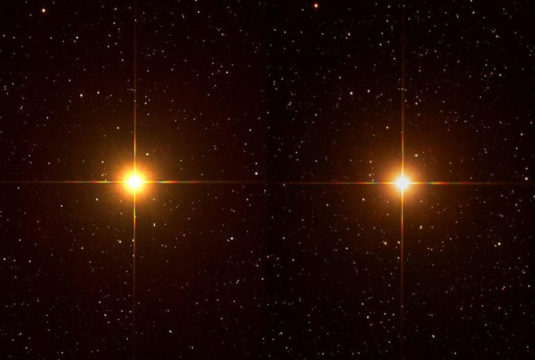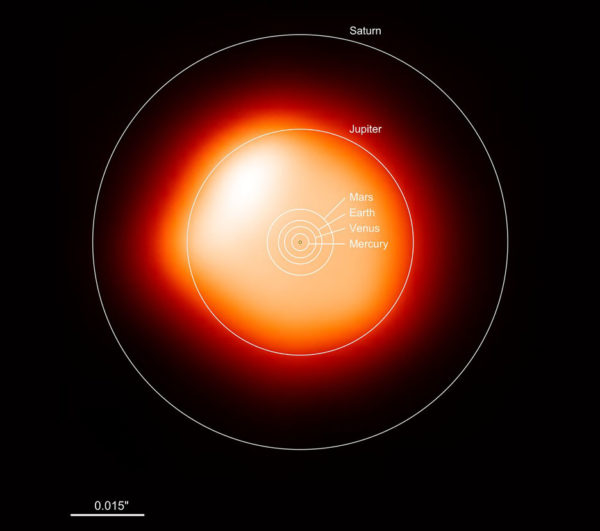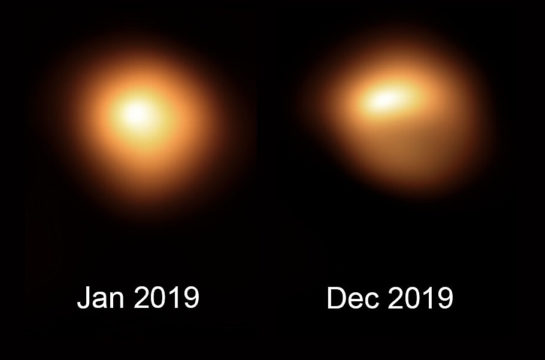Knowing Betelgeuse’s size is crucial to understanding its recent bizarre behavior — and predicting when it will go supernova. But it’s harder to figure out than you might think.

Courtesy of Brian Ottum and EarthSky
Earlier this year, furor surrounded Betelgeuse — the star had “fainted,” dimming more than expected in its usual cycle of brightness changes, leading some so far as to suggest the star might go supernova sometime soon. But even as astronomers begin to get a handle on the red giant’s unexpected behavior, they’re still struggling to understand its basic properties — namely its size and distance.
Meridith Joyce (Australian National University) and colleagues reported in the Astrophysical Journal (arXiv preprint available here) that Betelgeuse is actually smaller, and therefore closer, than previously thought. Not everyone agrees with the results. Nevertheless, the study represents a new — and needed — approach toward understanding this enigmatic giant.
Betelgeuse's Song
As a red giant star, Betelgeuse isn’t quite stable. It has run out of hydrogen to fuse in its core and is relying on helium fusion to hold off gravitational collapse. As it does so, pressure waves (that is, sound waves) move through the star so that it slowly pulses: The star swells, contracts, and swells again. Such pulses can help astronomers “listen” to a star’s interior structure, providing a view we would never otherwise see.

IAC
Using historical data collected by amateur astronomers of the American Association of Variable Star Observers, as well as archival observations from an imager aboard the Coriolis spacecraft, Joyce’s team assembled a light curve that shows how Betelgeuse’s brightness varies over time.
“In the case of both Betelgeuse and T UMi last year, having more than 100 years of visual data was critical,” Joyce explains. Her team was able to identify a pulsation with a period of 185 days. If we could hear the singing of this pulsing star, this 185-day cycle would be the first overtone, a pulsation occurring in the star’s outer layers on a resonant frequency.
Inputting this overtone into a computer simulation called Modules for Experiments in Stellar Astrophysics (MESA), Joyce modeled Betelgeuse’s outer layers, using the star’s swell-and-contract rhythm to determine its girth: between 702 and 880 times the Sun’s diameter. That’s enormous — yet it’s smaller than we thought. If Betelgeuse were in place of the Sun, the new estimate would have it extend two-thirds of the way to Jupiter instead of all the way.

ESO
Betelgeuse’s size on the sky is already known to some degree — while a point of light in most telescopes, infrared detectors can work together to resolve the star’s tiny spot 42 milliarcseconds across on the sky. If the distance to the star is known, then that angular diameter translates to its size. But Joyce’s team worked backwards: They compared the size calculated in their simulation to the angular diameter of the star, giving the distance to the star as between 500 and 636 light-years.
Dealing with Uncertainty
Betelgeuse’s distance has long been uncertain, and thus so has its size. For many stars, parallax is the go-to technique for measuring distance. Parallax is the apparent movement of a nearby star against more distant background sources over time, in the same way that a finger held at arm’s length appears to move as you peek at it with first one eye and then the other.
But Betelgeuse is so big, it’s not a point on the sky, the way most stars are. And it seems to be slightly asymmetric, perhaps due to ejections and/or interaction with its surroundings. That complicates parallax measurements.

ESO/M. Montargès et al.
The Hipparcos satellite was the first to measure Betelgeuse’s parallax in 1997, but right away astronomers knew something was off. The apparent movement of the star on the sky disagreed with radio measurements of its position.
Because calculating the star’s parallax depends on knowing not just its position but the apparent movement of its position on the sky, astronomers knew the distance was probably not quite right. “The 5-parameter solution is a simultaneous solution, so you can't trust one parameter if two of the others are wrong,” explains Graham Harper (University of Colorado, Boulder).
Recently, Harper set about correcting for this discrepancy. He combined radio measurements from the Very Large Array, Atacama Millimeter/submillimeter Array, and the e-Merlin array with revised Hipparcos measurements published in 2007, arriving at a distance between 620 and 880 light-years. Due to the complications involved in making the calculation, the range of possible values is “not small,” Harper says. If the distance were wrong, that would indicate the size is wrong too.
Joyce emphasizes that while different, the range in values her team found is within the range Harper reported: “This can be described as slightly different but statistically consistent,” she says.
“The new [study] uses completely independent methods that place much trust in numerical simulations of the structure of the star (which is not at all well-known) to see how the surface oscillates,” Harper says. “Such a completely independent approach is to be highly commended because the parallax method is going to remain problematic.”
Indeed, Joyce says, the ambiguity surrounding traditional parallax measurements is likely to remain in the near-future. (The European Space Agency’s Gaia satellite, which is determining parallaxes, and thus distances, to over a billion stars in the Milky Way, is so sensitive it can’t even observe bright Betelgeuse.)
Nevertheless, Harper urges caution with the new results. “You always need a ground-truth when developing new techniques. All the assumptions and uncertainties (known and unknown) can add up.”
Andrea Dupree (Center for Astrophysics, Harvard & Smithsonian) agrees. “I would be conservative and wait for some confirming calculations. But it is an interesting result.”
If the result pans out, it has some implications: A smaller Betelgeuse is likely at a slightly earlier stage of its lifetime, putting off any potential supernova. “It's burning helium in its core at the moment, which means it's nowhere near exploding,” Joyce says. “We could be looking at around 100,000 years before an explosion happens.”
 16
16









Comments
Andrew James
November 6, 2020 at 8:03 pm
There is an important point missing here. Radii for Betelgeuse is actually variable, something like a jellyfish swimming in the sea. Hence, Dolan, et al. (ApJ, 819, 7 (2016) radii being 500-1100 solar radii. The cause of the brightness changes is as a consequence of energy production in the core, assumed to fluctuate output because the nuclear fuel is running out, technically causing differences in opacity. This generates acoustic waves passing through the convective envelope/zone. These are s-called pressure modes or p-modes (as mentioned in their paper), that they assume is 416 day period. As the star ages, the pulsation cycles change into non-linear pulsations.
Alternatively, the brightness changes could be due to slow rotation of the star, where the star 'surface' is more bloated or uneven in different places that show differences in temperature. This is clearly seen on the IR images. Again it points towards the star is not exactly spherical.
It seems to me that everything in this paper hinges on the 'prediction" that the star's sol Radii being 764^+116-62 against Dolan, et al. (2016) radii being 500-1100 or 800 sol radii (with the uncertainty with the estimated maximum radii by interferometry and including limb darkening.)
So their Graph 1 & 2 clearly assumes mean radii, so when the article says "smaller Betelgeuse" it actually means "smaller mean radius Betelgeuse."
You must be logged in to post a comment.
Andrew James
November 6, 2020 at 10:47 pm
Note: The Wikipedia page on Betelgeuse has a sections on 'Diameter' & 'Distance measurements' which seems IMO shockingly derivative and highly cherry-picked. Most of its presented text revolves around Dolan et al 2016 paper, giving 887±203 solRadii, but not qualifying the maximum 1100 sol radii is really a guesstimate. This result of 764 is 764x197/168=895 solRad, and simply supports Dolan (2016) methodology with a differing distance. e.g. "This reduces the corrected angular diameter to 41.9±0.04mas. We adopt this as the best means to deduce a radius to compare with stellar models. This adopted angular diameter, combined with the VLA-Hipparcos distance and uncertainty of 197±45 pc, yields a radius of 887±203 R⊙ "Evolutionary tracks for Betelgeuse
You must be logged in to post a comment.
Peter Wilson
November 9, 2020 at 8:25 pm
Radii for Betelgeuse may also be diffuse.
A ball of gas has no definite edge. The Sun's size is generally given as the diameter of its photo-sphere, as light-emission ceases somewhat abruptly, below some threshold density. Having a mass of some 20 times that of the sun, and a volume roughly 420 million times greater, Betelgeuse’s photo-sphere may be comparatively fuzzy.
You must be logged in to post a comment.
Andrew James
November 9, 2020 at 9:25 pm
Nicely put. What you refer to is limb darkening, whose degree is quantifiable. Figures quoted take that into account. If this is based on an agreed definition, at least we can compare results.
You must be logged in to post a comment.
Tsagar
April 9, 2021 at 8:04 pm
Pardon my naivete but I do have a doubt. Is a time period of 10 million years adequate for planets to form (or semi form) AND get ripped apart? Also, the mass has to be large enough for the debris to obscure the parent star's radiation by such a substantial quantity as to be measurable a few hundred light years away? Keeping in mind that a behemoth (the parent star) is forming just a few blocks away and is gobbling up matter at an alarming rate, the wannabe planet may not have much chance in its endeavour!
I could be totally wrong though.
You must be logged in to post a comment.
Rod
November 7, 2020 at 6:42 am
Very interesting report. I checked some figures using my MS Excel astronomy spreadsheet I developed. Using a distance of 154 pc and angular size 42 mas, the diameter of Betelgeuse is 695.11 solar diameters or 6.468 AU. This report shows how difficult it can be to determine an accurate distance to the star and an accurate stellar diameter.
You must be logged in to post a comment.
Alan Potts
November 8, 2020 at 5:07 am
Excellent article Monica.
Thanks!
On the subject of the recent dimming one interesting speculation might be that dust from an orbiting, vaporized Betelgeusian planet, maybe at 9 to 12 AU, produced the light reduction. That would account for the assymetry/non-isotropy. It could be that the planet remains are in a very eccentric orbit and the recent event was a return to closest approach apsis (peribetelgeuse?). If so, it may have been some time, depending on the orbital eccentricity, since any previous dimming event.
You must be logged in to post a comment.
Alan Potts
November 8, 2020 at 5:22 am
Or, alternatively, the vaporized planet's remains could presently be at a significantly greater distance, having been pushed back by the radiation pressure since the time of vaporization (and subsequent dust formation). Hence in a much longer but less eccentric orbit.
However this is all rather speculative without any historical light dimming event observational backup.
I am wondering if only one observation was made at the VLT (December 2019)? A few further observations may have shown a drifting of the obscuring cloud across the face of the star.
You must be logged in to post a comment.
Andrew James
November 8, 2020 at 6:38 pm
At 9 to 12 AU, such planets couldn't survive inside a star. Tidal forces would disintegrate them and the stars atmospheric resistance (viscosity) would quickly strip it apart. (A little snack for Betelgeuse.0
Moreover. Mass range of planets are 10*24-10^26 kg, while Betelgeuse is >10^31 kg. By area, Betelgeuse is 9.8 million sq AU, whilst a Jovian sized planet is ~10^-7 su. AU - factor of 10^15!!! Compared to red giants, planets are just pipsqueaks.
You must be logged in to post a comment.
Alan Potts
November 10, 2020 at 8:12 am
Sorry, but my hypothesis is that the remnants of a vaporized planet, not a standard planet produced the dimming dust.
Also, regarding tidal forces, if evaluate the tidal force on earth orbiting the sun at 1AU and compare to the tidal force on the earth at 10AU orbiting a 15 solar mass entity (approx to Betelgeuse) then the tidal force due to Betelgeuse is approximately 1/12th that due to the sun. (The mass of Betelegeuse or sun can be placed at a point at the star's center as per Newton). So Betelgeuse is, despite its mass, not a tidally disruptive object, in this picture. Of course, the tidal force on a vaporized planet would be very large, even at 10AU so it would be disrupted. Hence this would be a 1-off vaporization/dimming event.
You must be logged in to post a comment.
Andrew James
November 10, 2020 at 5:18 pm
There is no evidence for this. If anything, such an event would likely make the star become slightly brighter not dimmer.
My comments and this story are towards the star's size not about recent dimming.
You must be logged in to post a comment.
John-Murrell
November 10, 2020 at 8:22 am
Apparently Gaia should be able to measure the parallax for Betelgeuse using a 'special mode'. This was planned but got interrupted by some of those involved being badly infected by COVID-19. I am not sure if the special observations and analysis required has restarted or not.
You must be logged in to post a comment.
Andrew James
November 10, 2020 at 5:50 pm
GAIA will not improve the problem of radius nor distance, as the parallax of c.5.95 mas is smaller than the observed angular diameter of 41.9 mas. Combined with the star's variable radius doesn't help matter. ESA GAIA on this says: "Some of these bright stars are being observed with a special mode on board the spacecraft, requiring to predict when it passes the focal plane and then telling the on board computer to record the relevant pixels around the position of the star." Stars above 3rd mag. (50 stars) are "...are too bright for Gaia to observe." Betelgeuse is one of them.
You must be logged in to post a comment.
John-Murrell
November 13, 2020 at 3:54 pm
Andrew, my information that the parallax could be measured by Gaia comes from quite close to the senior scientists for the Gaia mission. The analysis is complicated and they intended to employ someone specifically to do this.
Some information on the bright star capability of Gaia can be found in https://authors.library.caltech.edu/72000/1/99042E.pdf and the references in this paper.
You must be logged in to post a comment.
Andrew James
November 13, 2020 at 4:56 pm
My quote is here.[1] I can not find data for a bright star. Why is that? There is no guarantee that data will be available (even DR4.), which is why the text on this is ambiguous. The article says: "In addition, there are many very bright stars of particular interest and Gaia data may help us to refine our knowledge of their properties." Distance will be better found by indirect means, like finding companions / exoplanets and detecting their motion, which is why this is stated under binary stars. It would been nice if the GAIA team were more specific here, as I read "...the prospects for a more powerful mode." and "For extremely bright stars (G<3) the probability of obtaining nominal Gaia data is very low," and "...there is no pipeline or any other software that is ready to process these data." isn't clear.
This paper is 2006, so there might be more results unbeknown to me.
You must be logged in to post a comment.
JamesMxElger
November 14, 2020 at 12:49 pm
This problem could easily be solved by placing two radiotelescopes in orbit around the sun for the sake of interferometery, and the size of the arpeture! We places one telescope one quarter ahead of the Earth, the other satellite one quarter ahead of the Earth, in it's orbit, then triangulate! About the same position as the STEREO solar observatories!
You must be logged in to post a comment.
You must be logged in to post a comment.